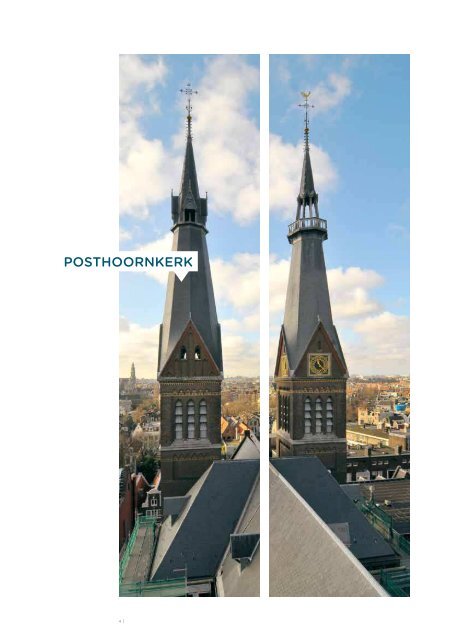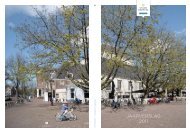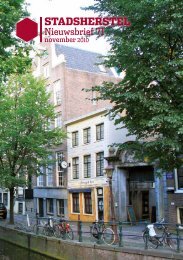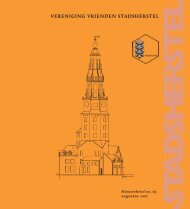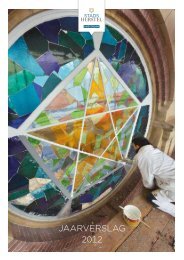StadSherStel amSterdam
StadSherStel amSterdam
StadSherStel amSterdam
- No tags were found...
Create successful ePaper yourself
Turn your PDF publications into a flip-book with our unique Google optimized e-Paper software.
StadsherstelAmsterdam N.V.The Company for City RestorationposthoornkerkSince its founding 55 years ago, Stadsherstel Amsterdam has developed into a restoration companyfor all kinds of monuments in an urban or rural environment. It not only restores, but alsopreserves these monuments in such manner, that the character of the building is left intact andthat further development will not cause any damage to the architecture, or change it in any way.Currently Stadsherstel owns more than 500 houses and 30 larger monuments, e.g. churches andindustrial monuments like pumping-stations and a shipyard. It is partly thanks to the exampleset by Stadsherstel, that the historic centre of Amsterdam became a very sought-after residentialarea.The neo-Gothic Posthoornkerkis the firstchurch in Amsterdamcreated by renownedarchitect P.J.H. Cuypers,who would laterdesign Centraal Stationand the Rijksmuseum.The church, a crossshapedbasilica witha three-way nave andclover-shaped choir,had to be built on asmall space. As a result,the second gallerywas built on top of theother. The constructionstarted in September1861. By the 1980s, thechurch was no longerin use and was nearlydemolished. However,this was prevented in1986 by a plan drawnup by the PosthoornkerkFoundation. Sinceits restoration andreconstruction, thechurch has been rentedout as office space,as well as used as alocation for receptionsand dinners. The Vondelkerk– which wasalso designed by Cuypers– was preserved inthe same way.Amsterdam after theSecond World WarAs in most cities in Europe, the historic part ofAmsterdam was in desperate need of restorationafter the Second World War. Although Amsterdamdid not suffer much war damage, since there hardlyhad been any bombing, the inner city looked like awar zone. Part of the damage was caused by neglectand lack of maintenance during the depressionyears in the 1930’s. The larger part of the deterioration,though, had a much more sinister cause. Thehouses of the deported Jews were stripped of allthe wooden parts, including supporting beams,when the German occupier forbade the sale of fuelto civilians. The wood ended up in the stoves of theAmsterdam citizens.During the post war period, both the central andlocal authorities in The Netherlands concentratedon the construction of as many houses as possiblein suburban areas. The old city centres were notconsidered appropriate for the housing of people.Thus the unique townscape of numerous historicdwelling houses in Amsterdam was being neglected.According to the Amsterdam city council theinner city was more suitable as a business centre,shopping area and for cultural purposes like opera,concerts, museums and the theatre. This meantthat it was necessary to make the centre accessibleto automobiles, which involved filling up canalsand converting them into roads. It also meant pullingdown houses in order to have enough space forthe vehicular flow to and from the centre and forcar parks in the inner city. The buildings consideredless valuable - including many 17 th and 18 thcentury dwelling houses - were to be pulled downfor this modernisation. Only the more remarkablebuildings were to be restored. These measureswould result in the erosion of the townscape.The acceptance of these plans by the city councilin the early 1950’s marked the beginning of a countermovementby the local inhabitants. The peoplecame to see that the historic centre was indeed verydecrepit, but not at all lost and very worthwhilesaving. The more the results of these plans came tolight by actual demolishing of complete streets, themore the protests grew.At first the countermovement was carried by respectablemonument lovers from the upper strataof society. It was characterized by the search forcooperation with the local authorities and by takingrestorations of the smaller dwelling houses intotheir own hands. But in the sixties the protest generationsided with the monument lovers and theirway of working was quite different. They soughtthe confrontation with the authorities. This peculiaralliance led ultimately to a change in policy ofthe local government. The large-scale destructionof the historic structure of the city made way fora street-to-street approach. In this approach theexisting buildings were the starting point aroundwhich the plans were drawn up. In the areas wherelarge scale demolishing had already taken place,the new buildings were put up according to the oldstreet patterns.In Amsterdam - and indeed in the whole of TheNetherlands - the idea of how to develop historiccities changed during the 1960’s and 1970’s. Thischange was brought about by concerned citizens,who fought for their living environment and cultur-4 | 5 |


